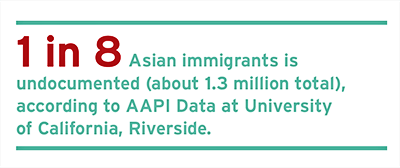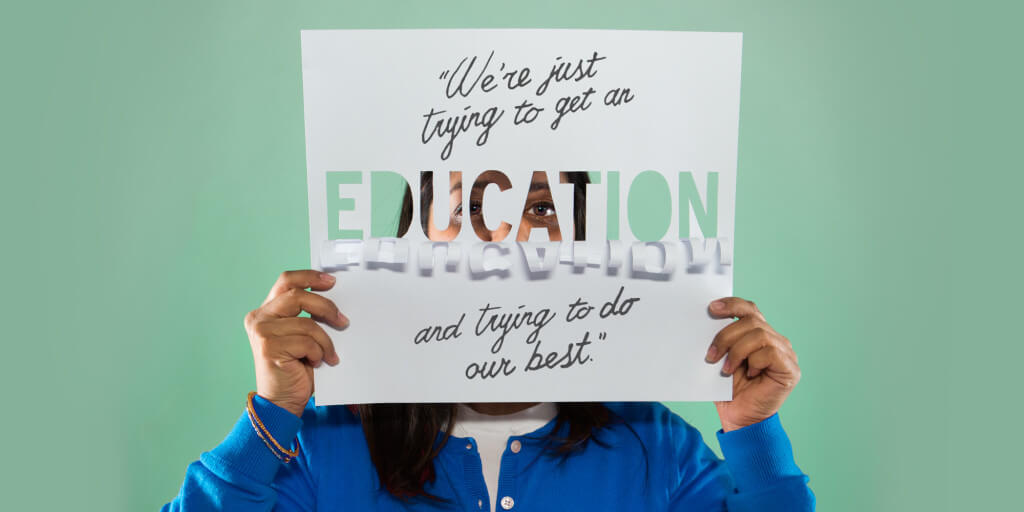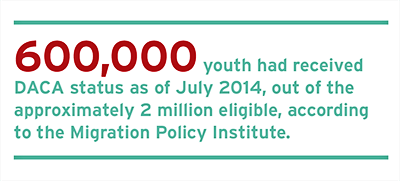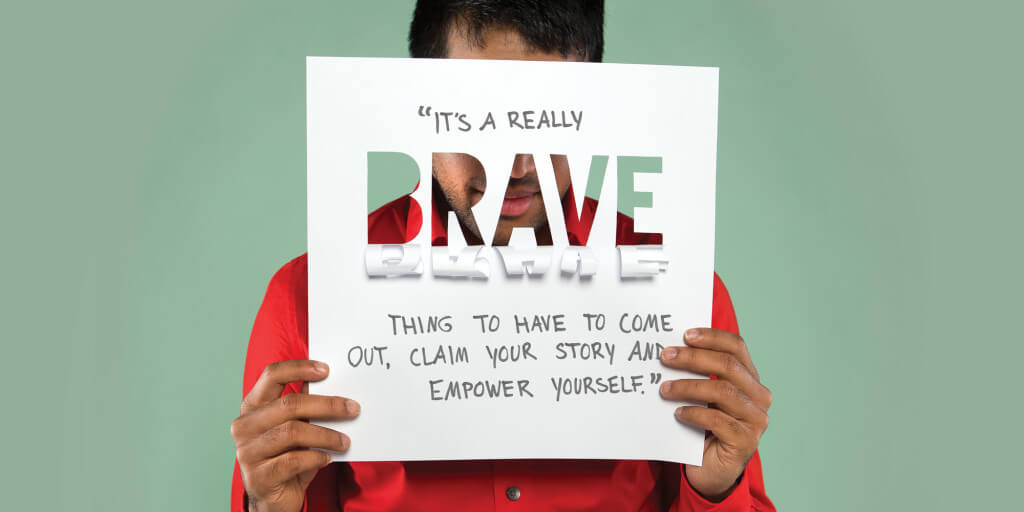- February 10, 2015
- By Karen Shih ’09
Locked in a cell at an Eastern Shore detention center, Jorge Steven Acuña faced a bleak future, one in which he was more likely to be conscripted into the Colombian army than create chemical reactions at the University of Maryland.
He and his parents, political activists in Colombia, had fled their native country when he was 8, seeking asylum after receiving death threats. But 11 years later, it looked like they would be sent back: Immigration officials in March 2012 arrested the family of undocumented immigrants at their Germantown home.
Steven silently said goodbye to his plans of becoming an orthopedic surgeon. He knew his Spanish wasn’t strong enough to get him through even an introductory biology class. His injured knee couldn’t withstand the country’s two years of required military training.
“I imagined myself…in the middle of some tropical area, knowing about the drugs and the corruption there,” he says. “I saw myself dying.”
But he was lucky: After his friends whipped up a media frenzy and won the support of high-profile lawmakers, the Acuñas were released and granted a reprieve on their deportation orders.
Steven, spurred to action by his close call, spent the rest of the year campaigning on behalf of the Maryland Dream Act, legislation that would give undocumented students a chance to pay in-state public college tuition.
“To be a better person I need a better education,” he says. “We all have the dream to do better than our parents. If you’ve been in my situation, feeling so pressured and hopeless, you want to give back, especially to those who want to go to school.”
he bill passed by voter referendum, and today, he is one of nearly 100 UMD students paying the reduced tuition through either the Dream Act or President Barack Obama’s 2012 executive order deferring deportation for certain children brought into the country illegally.
With no federal DREAM (Development, Relief and Education for Alien Minors) Act on the books, the 17 states that give undocumented immigrants access to in-state tuition are on their own. As the students struggle with deportation fears, financial obstacles and endless red tape, the university faces its own challenges in meeting their needs.
“I think we need to be doing more,” says Associate Vice President and Chief Diversity Officer Kumea Shorter-Gooden. “We need to more holistically address the needs and challenges of our undocumented students.”
 Laws and Orders
Laws and Orders
The absence of national policies has left state and local governments to grapple with the on-the-ground consequences of an estimated 11.4 million undocumented immigrants. Children are often at the center of that debate.
The federal DREAM Act, proposed in 2001, would have provided a path for children brought to the country illegally to eventually qualify for permanent residency.
Though it passed with bipartisan support in the House, opponents argued that the newcomers would take jobs from citizens and strain the nation’s schools and health-care system, and the bill died in the Senate. No votes have been held since 2010.
Obama salvaged parts of that legislation two years later for his “Consideration of Deferred Action for Childhood Arrivals” (DACA) executive order. It states that immigrants who were under age 31 on June 15, 2012, had come to the United States before age 16, had continuously resided in the U.S. for five years, and were currently in school, graduated high school or served in the U.S. military, among other criteria, could be protected from deportation and receive a work permit. Obama’s November 2014 executive order extended DACA renewal from every two years to every three years and broadened the number of youth who could qualify. The $465 renewal cost, however, is prohibitive to many immigrants, and citizenship is still off the table.
In Maryland, the General Assembly proposed and passed its own Dream Act in 2011, focused on higher education only. But opponents—including Democrats, as the issue didn’t split along party lines—collected more than 60,000 signatures, enough to turn it into a referendum before voters in the next election.
“Many of our state’s colleges and universities are filled to capacity with students, as enrollment has spiked during our country’s economic struggles,” wrote Democratic Baltimore County Del. Joseph Minnick in the Dundalk Patch in 2012. “Working adults are flocking back to the classroom to boost their resumes while they’re unemployed or underemployed. Lecture hall seats should be available to them—legal residents—rather than undocumented men and women.” (Today, Minnick no longer objects to in-state tuition for undocumented students.)
UMD President Wallace Loh, a Chinese-Peruvian immigrant himself, was a vocal supporter of the Maryland Dream Act.
“We know that education is the great equalizer in our democracy. It is the passport to social and economic mobility,” he wrote in The Washington Post before the vote. After educating K–12 students, “it is a waste of investment and talent to then slam the door on those with the ability and motivation—but limited money—to go to college.”

Living in the Shadows
For some undocumented students, education is more than an equalizer. Amid constant fear of deportation—when, where, how?—it can be a lifeline, something they can control.
“Just imagine, you’re going to school, and at home, your parents might get deported,” says Steven, a chemical engineering major. “They might call you up in the middle of an exam and say, ‘That’s it, we’ve made it as far as we can. It’s up to you now.’ It’s a scary thought.”
Since 2000, the Department of Homeland Security has removed more than 4.1 million individuals who were in the country illegally—including the parents of December biochemistry graduate James D’Souza*.
He was just a year old when they brought him to the U.S. to escape violent religious clashes in India. For their first 12 years in Maryland, he says, “we lived what people refer to as the American dream.”
As asylum seekers, they got Social Security numbers and work permits, so James’ father waited tables at high-end restaurants in Washington, D.C., and his mother taught computer science at a community college. His younger brother was born an American citizen, and eventually, they bought a house.
But their case was ultimately denied in 2006, after several appeals. Three years later, a broken taillight alerted authorities and brought immigration officials to their home. They arrested James’ father, then sent him from detention center to detention center for months before deporting him. His mother was given a year’s reprieve to sell their house and find a place for her children to live. She was tracked with an ankle bracelet and required to regularly report to the immigration center in Baltimore, before she, too, was deported. (Had they managed to stay another five years, they would have qualified under Obama’s new executive order that gives parents with American-citizen children three-year reprieves.)
“It was the toughest time of my life,” James says, “to see my mom have to go through what she did. She was treated like an animal.”
He told no one, concerned that his friends and teachers would judge or reject him. Instead, he focused his energy on the nine Advanced Placement classes he took his junior and senior years. It wasn’t until his own deportation loomed that he started to share his story.
Elsa Garcia* ’16, whose family also fled Colombia to escape political instability, kept quiet too, choosing to throw herself into activities like class council and the school paper. It finally hit her during senior year that her lack of official immigration papers made her different.
“I was kind of in denial,” she says. “When I heard my friends say they were applying to college here and there, it made me play along. I never doubted I would continue my education, but at some point it did become really real that going to a four-year institution was not going to happen.”
 No FAFSA, No Future
No FAFSA, No Future
The key reason students like Elsa couldn’t imagine going to UMD before the Maryland Dream Act is this: The average cost of four years’ tuition ranges from $35,000 at in-state public institutions to more than $120,000 at private institutions, according to the College Board.
Nationally, most college students—about two-thirds—qualify for some sort of financial aid, including grants, loans or work-study.
Undocumented students don’t have that option. Federal financial aid, which requires students to fill out the Free Application for Federal Student Aid (FAFSA), is off-limits to them. Since states and private foundations frequently award scholarships based on the FAFSA, they also miss out on many other funding opportunities.
And unsurprisingly, families of undocumented students often lack financial resources. Steven’s parents were an accountant and a nurse, respectively, in Colombia, but they couldn’t afford the continued schooling or certifications needed to continue in their professions in the U.S., so they instead had to settle for jobs as a handyman and a nanny. To pay for school, Steven tends bar 30 hours a week. He saves on housing costs by commuting from his parents’ Germantown home, but this reduces the time he can devote to his engineering courses by another 10 hours per week.
“You’re always fighting for your money,” says Steven, who became an expert at arguing fees with telephone and power companies and banks to help his Spanish-speaking parents. “You know any money you save them could be your food, or your shirt.”
The implications of these financial burdens are stark: An estimated 65,000 undocumented students graduate from high school each year, but just 5 to 10 percent attend college, reports the Pew Hispanic Center.
That’s why Steven stepped up when the Maryland Dream Act was on the ballot. He and James, then Montgomery College students, led the local student movement. They criss-crossed the county, the state and even the country, working with CASA de Maryland, which spearheaded the state campaign, and national organizations like United We Dream to advocate for various states’ Dream Acts. Steven spent weeknights and weekends speaking at churches and rallies to mobilize voters. James, who had started a student club for undocumented students and allies, testified in front of the Maryland General Assembly.
“It was heartbreaking to see it go to referendum, but we were able to get it through,” says James. “The people of Maryland had our back.”

Someone to Talk To
After the frenzied campaigning for the Maryland Dream Act, its passage seemed like the final step. But as one of the pioneers in enacting this kind of legislation, the university is still learning how to identify prospective students and support them once they’re on campus.
In Fall 2014, there were 34 UMD Dream Act students and an estimated 50 to 60 DACA students, says Assistant Registrar Michelle Tan. The former are officially tracked, while the latter are not, based on state policy.
Those with DACA status face an easier process qualifying for in-state tuition, because they have to fulfill only the regular residency requirements and add their deferred action document—though applying and proving their status to the federal government has its own risks and challenges. Students seeking in-state tuition through the Dream Act must supply qualifying documents directly to the university’s residency classification office. But they don’t always know where to find the forms, how to fill them all out or where exactly to drop them off. (“There was paperwork for days,” Steven recalls.)
Janelle Wong, director of the Asian American Studies Program, along with Program Coordinator Grace Lee has helped many undocumented students navigate the system. She says they “aren’t certain what they can reveal in particular offices,” which keeps them from accessing resources like the Keep Me Maryland emergency financial aid fund and counseling services.
Two grassroots initiatives sprang up in Fall 2014 to support undocumented students. James co-founded the student group Legitimizing and Uniting a Network of Undocumented Americans (LUNUA) to create a pipeline from high school through community college to UMD. Yvette Lerma, coordinator for Latino student involvement and advocacy at the Office of Multicultural Involvement and Community Advocacy, created the UndocuTerp Collective to connect and educate faculty and staff from all areas of campus, including admissions, the health center and resident life.
In November, Wong and Lerma initiated a meeting with the coordinator of the University of California, Los Angeles (UCLA) Undocumented Student Program. Formally established about a decade after California’s in-state tuition law was passed in 2001, the program offers everything from textbook lending to nutrition sessions to campus ally training. Wong hopes Maryland can emulate schools like UCLA and those in Texas and Arizona that have websites and full-time staff members dedicated to helping these students, who she describes as “living in the shadows.”
“I would love to have someone to talk to,” says Elsa, who’s studying government and politics and journalism. She’s hesitant to reveal her status because “I don’t know what the person next to me is going to think. I don’t know what their ideology is. I don’t know what kind of reaction they’re going to have to me.”
She’s hopeful that the new steps will help undocumented Maryland students. In the meantime, she, Steven and James are looking ahead to their own futures, which are temporarily secure with DACA status, but liable to change after a new president is elected in 2016. Steven still intends to go to medical school, Elsa wants to earn a master’s degree in international affairs and work as a diplomat, and James plans to attend pharmacy school in the fall.
“People think we’re just here, running aimlessly, like we have no dreams,” Steven says. “I’ve fought so hard to get to this school, and I really cherish this opportunity. Being at a university while you’re undocumented, it really humbles you.” TERP
*Name changed to protect student’s identity
Tags
Student Experience